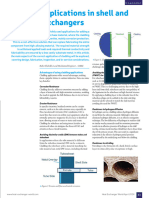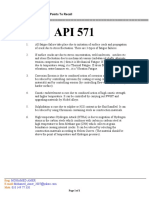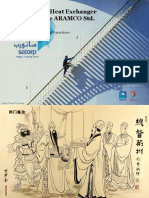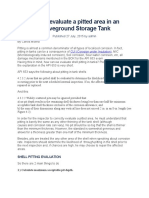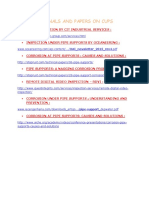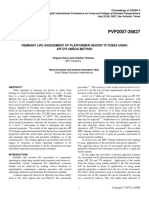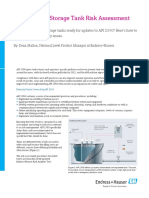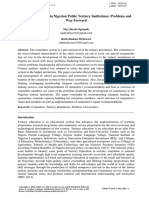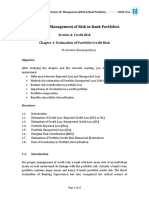Remaining Life Assessment of Refinery Fu
Uploaded by
Jose Marval RodriguezRemaining Life Assessment of Refinery Fu
Uploaded by
Jose Marval RodriguezRemaining Life Assessment of Refinery Furnace
Tubes Using Finite Element Method
Barhm Abdullah Mohamad, Abdelsalam Abdelhussien
Petroleum Technology Department, Koya Technical Institute, EPU, KRG, Iraq
International Journal of Research in Mechanical Engineering Volume 4, Issue 2,
March-April, 2016, pp. 06-09
ISSN Online: 2347-5188 Print: 2347-8772, DOI: http:// doi.org / 10.6084 /m9
© IASTER 2016, www.iaster.com
ABSTRACT
Crude oil heater 9Cre-1Mo steel tubes from a refinery plant were studied, after 5 years of service at
nominally 650 Cº and 3 bar, to predict their remnant lives. The investigation included dimensional,
hardness and tensile measurements in addition to accelerated stress rupture tests between 650 Cº and
700 Cº and microstructural examination. Tube specimens were taken from two sections, the overheated
side and the side which only saw the nominal operating temperature. The method employed involved the
prediction of the increase in temperature with increasing sediment deposition during the operating life
times using an FEM model. In addition the predicted temperatures are used to derive appropriate creep
properties at relevant temperatures in a 3D pipe FEM creep analysis to predict the pipe deformation
rate. All compare well with the actual service exposed pipe measurements and layer deposition. The
overheated side revealed a small loss of creep strength in a stress rupture test. A layer of sediment
(appr. 10 mm thickness) consisting basically of sintered carbon (coke) spread over the inside of the tube
was acting as a thermal barrier causing the temperature to rise above 650 Cº. Analysis for the
overheated side predicted an upper bound temperature of 800 Cº and a life of about 50 h suggesting that
failure by creep rupture could occur rapidly in the sediment region.
Keywords: Refinery Furnace Tube Design, Thermal Stress Test, Stress and Temperature
Distribution, Finite Element Method, Solid Modeling, Failure Analysis.
1. INTRODUCTION
Internally pressurized tubes are critical components in heat exchanger applications, such as boiler
water tubes, steam super heater elements and chemical plant reformer tubes [1, 2]. Such tubes in
power plants have a finite life because of prolonged exposure to high temperatures, stresses and
aggressive environments.
Remaining life assessment of aged power plant components in the present highly competitive
industrial scene has become necessary both for economic and safety reasons as most of the power
plants are over 25 years old. In real life situations both premature retirement and life extension in
relation to the original design life can be encountered [2].
The consequences of failure of a component in use can be tragic and expensive. There are many cases
of engineering disasters resulting in loss of life and property. For boiler components, utmost attention
is required to ensure that such incidents cannot take place. Carbon and 9Cre-1Mo steels are
extensively used in high temperature components in power plants. Even though most of these
components have a specific design life of 20 years, past experience has shown that they can have
significant remaining life beyond the original design specification [3].
6
International Journal of Research in Mechanical Engineering (O) 2347-5188
ISSN
Volume-4, Issue-2, March-April, 2016, www.iaster.com (P) 2347-8772
One of the most widely used techniques for life assessment of components involves removal of
service exposed alloy and conducting accelerated tests at temperatures above the service temperature
[4]. The aim of the present work is to evaluate the remaining life of Crude oil heater 9Cre-1Mo steel
tubes from a refinery plant, after 5 years of service, based on experimental and numerical analysis.
2. EXPERIMENTAL PROGRAM
The material specification with service condition and history of operation of the exposed 9Cre-1Mo
steel super heater and re-heater tubes from a refinery furnace that heats crude oil at 350 Cº, but
outside tubes (convection zone and radiation zone) were around 650-690 Cº.
So we have a furnace tube design, operating and safety information’s are given in Table 1. Due to
impurities in crude oil, basically sintered carbon (coke) has been deposited on the lower half of the
tube section (Fig. 2.2). In this section, the rate of heat transfer from the tube to the crude oil
would therefore decrease. In order to keep the temperature of the crude oil constant at 350 Cº more
heat is required and subsequently material at this section (Fig. 2.2) will experience a higher
temperature in comparison to the other side.
This increase of temperature leads to higher physical and metallurgical damage, hence leading to a
shorter safe operating time. In this article an experimental comparison has been made between the
overheated and not-overheated side using manufacturing details and FEM results.
Table 1.Material Specification, Dimension and Condition of the Service Exposed Tubes (9Cre-1Mo Steel)
Material Specification/Grade of Steel (ASTM) A220-T9
Design oil pressure (bar) 6
Operating steam pressure (bar) 4
Design inner surface temperature(C) 420
Operating inner surface temperature (C) 400
Operating outer surface temperature (C) 690
Tube thickness (mm) 6.35
Inner diameter (mm) 168
Service exposed (h) 43200
Fig.2.1 One Stack Box Type - Refinery Furnace
7
International Journal of Research in Mechanical Engineering (O) 2347-5188
ISSN
Volume-4, Issue-2, March-April, 2016, www.iaster.com (P) 2347-8772
Fig.2.2 Higher Temperature Cause Sintered Coke Usually
at the Bottom of Tubes in Convection Zone, and when the
Temperature Distribution Comparison to the Other Side.
3. THERMAL ANALYSIS
The FEA Command CONV is applied on inner side of
the model CONV are applied on outer side of the model.
Solid 87 3-D 10-Node tetrahedral thermal solid (fig.3.1)
is well suited to model irregular meshes.
The element has one degree of freedom, temperature, at
each node. The boundary conditions presented in Fig.3.1.
And maximum induced thermal stresses are presented in
Fig.3.2 & Fig.3.3. As such under the actual operating conditions the component would be safe. The
maximum temperature redeveloped is 400Cͦ which is less than the recommended operating of
(ASTM) A200-V01.
Fig.3.1.The Boundary Conditions
Fig.3.2.Maximum Induced Stresses
8
International Journal of Research in Mechanical Engineering (O) 2347-5188
ISSN
Volume-4, Issue-2, March-April, 2016, www.iaster.com (P) 2347-8772
Fig.3.3.Detailed View of Maximum Induced Stresses
4. CONCLUSIONS
Crude oil heater 9Cre-1Mo steel tubes from a refinery plant after 5 year of service at nominally 650C̊
and 3 bar were studied to predict their remnant life. A software program using accelerated creep testing
and metallographic investigation in parallel with a numerical analysis was used to perform the remnant
life calculation of the service aged tubes. The method employed involved the prediction of the increase
in temperature with increasing sediment deposition during the operating life times. In addition the
predicted temperatures were used to derive appropriate creep properties at relevant temperatures in a 3D
pipe FEM creep analysis to predict the pipe bending deformation rate. These compare well with the
actual service exposed pipe measurements and conditions. All results indicate that in the overheated side
of the tube, the creep life was reduced substantially but on the side under normal operating temperature
significant remnant life still exists. It is also shown that the growth of sediment thickness is
approximately proportional to the rise in temperature and pipe deformation (pipe bend).
The stresses induced in the tubes as shows in fig.3.3 and fig.3.2 are complex and ANSYS macro can
handle this kind of complex shapes easily. The stress levels are within acceptable limit as per ASTM,
A200-V01. As such under the actual operating conditions the component would be safe. The maximum
ͦ̊ ̊
temperature redeveloped is400C which is less than the recommended operating of
9Cre-1Mo Material.
REFERENCES
[1] Jones DRH. Creep Failures of Overheated Boiler, Superheater and Reformer Tubes.
Engineering Failure Analysis 2004;11:873e93.
[2] Ray AK, Tiwari YN, Sinha RK, Roy PK, Sinha SK, Singh R, et al. Remnant Life Assessment of
Service-Exposed Pendent Superheater Tubes. Engineering Failure Analysis 2002;9(1):83e92.
[3] Tamil Mannan K., Saxena R., Murugavel Rathinam, Sah P. L “Coupled Field Analysis of
Pressure Vessel Furnace Tube Reducer Using Finite Element Method’ International Journal on
Design and Manufacturing Technologies, Vol.3, No.1, January 2009.
[4] J. F. Harvey, P.E, 1991, Theory & Design of Pressure Vessels, CBS Publishers and
Distributors, New Delhi.
[5] “Creep Life Assessment of an Overheated 9Cr-1Mo steel Tube” M. Mazaheri, F. Djavanroodi,
K.M. Nikbin, International Journal of Pressure Vessels and Piping 87 (2010) 746e752.
You might also like
- Creep of Outlet Pigtail Tubes of Steam Reformer and Grain Size Effect On Creep of An Incoloy 800H Material100% (1)Creep of Outlet Pigtail Tubes of Steam Reformer and Grain Size Effect On Creep of An Incoloy 800H Material12 pages
- 10.1515 - htmp-2013-0041 Performance and Life Assessment of Reformer TubesNo ratings yet10.1515 - htmp-2013-0041 Performance and Life Assessment of Reformer Tubes14 pages
- Stress Analysis and Creep Life Prediction of Hydrogen Reformer Furnace TubeNo ratings yetStress Analysis and Creep Life Prediction of Hydrogen Reformer Furnace Tube14 pages
- SSW - April 2020 - Lowres Pages 42 45 PDFNo ratings yetSSW - April 2020 - Lowres Pages 42 45 PDF4 pages
- Floating Head Heat Exchanger MaintenanceNo ratings yetFloating Head Heat Exchanger Maintenance14 pages
- Abilene, Inc.: An Introduction To Boiler MaintenanceNo ratings yetAbilene, Inc.: An Introduction To Boiler Maintenance19 pages
- Understandingheatexchangerreading03 Thearamcostd 180531020452No ratings yetUnderstandingheatexchangerreading03 Thearamcostd 180531020452123 pages
- Which Procedures For Fitness-For-service Assessment - API 579 or BS 7910 - (July 2003)No ratings yetWhich Procedures For Fitness-For-service Assessment - API 579 or BS 7910 - (July 2003)9 pages
- Managing Corrosion Challenges Associated With Heat Exchangers100% (1)Managing Corrosion Challenges Associated With Heat Exchangers53 pages
- A Brief Presentation On Hot and Cold InsulationNo ratings yetA Brief Presentation On Hot and Cold Insulation5 pages
- Repair of Tube-Tubesheet Weld Cracks in A Cracked Gas/Steam Heat ExchangerNo ratings yetRepair of Tube-Tubesheet Weld Cracks in A Cracked Gas/Steam Heat Exchanger8 pages
- API 579-Part 4 -(Level 1 and Level 2+ EP Verification)No ratings yetAPI 579-Part 4 -(Level 1 and Level 2+ EP Verification)33 pages
- Steam Boiler Inspections Using Remote Field Testing: by Mynor Celis, P.Eng, Russell NDE Systems0% (1)Steam Boiler Inspections Using Remote Field Testing: by Mynor Celis, P.Eng, Russell NDE Systems11 pages
- TRISTAR-Tube Expanders For Heat ExchangersNo ratings yetTRISTAR-Tube Expanders For Heat Exchangers24 pages
- Fitness for Service (FFS) - An Introduction to Leve 1 and Level 2 FFS assessmentsNo ratings yetFitness for Service (FFS) - An Introduction to Leve 1 and Level 2 FFS assessments85 pages
- Requirements For Shell and Tube Heat Exchangers - TEMA StandardsNo ratings yetRequirements For Shell and Tube Heat Exchangers - TEMA Standards1 page
- Investigation and Repair of Heat Exchanger FlangeNo ratings yetInvestigation and Repair of Heat Exchanger Flange12 pages
- Preventing Heat Exchanger Tube Failures 0No ratings yetPreventing Heat Exchanger Tube Failures 027 pages
- Coke Drum Repair Welch Aquilex WSI DCU Calgary 2009No ratings yetCoke Drum Repair Welch Aquilex WSI DCU Calgary 200937 pages
- Retubing Plan On Heat Exchanger in Methanol PlantNo ratings yetRetubing Plan On Heat Exchanger in Methanol Plant22 pages
- Different Types of Pyrolysis Coil Failure: Rob Gommans M.SCNo ratings yetDifferent Types of Pyrolysis Coil Failure: Rob Gommans M.SC10 pages
- 51CCJ2016Q4 - HRSG - Risk-Based PlanningNo ratings yet51CCJ2016Q4 - HRSG - Risk-Based Planning17 pages
- 13542015125446_17292013032950_02-Inspection in Refineries - CorrosionNo ratings yet13542015125446_17292013032950_02-Inspection in Refineries - Corrosion57 pages
- Basic Refinery Equipment - Heat Exchanger (E003/1)100% (1)Basic Refinery Equipment - Heat Exchanger (E003/1)27 pages
- API STD 620 Interview Questions and Answers: The Guide for Storage Tank EngineersFrom EverandAPI STD 620 Interview Questions and Answers: The Guide for Storage Tank EngineersNo ratings yet
- API 510 Interview Questions and Answers: The Essential Guide for Pressure Vessel InspectorsFrom EverandAPI 510 Interview Questions and Answers: The Essential Guide for Pressure Vessel InspectorsNo ratings yet
- Effect Scale Formation in Boiler Water Wall TubesNo ratings yetEffect Scale Formation in Boiler Water Wall Tubes7 pages
- Remnant Life Assessment of Platformer Heater T9 Tubes Using Api 579 Omega MethodNo ratings yetRemnant Life Assessment of Platformer Heater T9 Tubes Using Api 579 Omega Method9 pages
- Failure Analysis and Remaining Life Assessment of Service Exposed Primary Reformer Heater TubesNo ratings yetFailure Analysis and Remaining Life Assessment of Service Exposed Primary Reformer Heater Tubes21 pages
- Integrated Approach RLA of Reformer Tubes NDT (ARTiS) PDFNo ratings yetIntegrated Approach RLA of Reformer Tubes NDT (ARTiS) PDF8 pages
- Development of EMBrEMS Multifunction MoldNo ratings yetDevelopment of EMBrEMS Multifunction Mold5 pages
- Modelo Distribuidor Assessment of Discretisation Schemes 23No ratings yetModelo Distribuidor Assessment of Discretisation Schemes 2310 pages
- Electromagnetic Stirring in Continuous Casting ProcessNo ratings yetElectromagnetic Stirring in Continuous Casting Process4 pages
- Study of The Deskulling Problem of Tundishes in Continuous CastingNo ratings yetStudy of The Deskulling Problem of Tundishes in Continuous Casting14 pages
- Api Performing A Storage Tank Risk Assessment v2No ratings yetApi Performing A Storage Tank Risk Assessment v23 pages
- Applications Steel: Plexicoke in The VmezuelanNo ratings yetApplications Steel: Plexicoke in The Vmezuelan8 pages
- Secondary Steelmaking Refractories: A Practical Training SeminarNo ratings yetSecondary Steelmaking Refractories: A Practical Training Seminar4 pages
- Draft JCPS Superintendent Contract ExtensionNo ratings yetDraft JCPS Superintendent Contract Extension11 pages
- Communication Ethics: Dr. Naveen K MehtaNo ratings yetCommunication Ethics: Dr. Naveen K Mehta12 pages
- Committee System in Nigerian Public Tertiary Institutions: Problems and Way ForwardNo ratings yetCommittee System in Nigerian Public Tertiary Institutions: Problems and Way Forward9 pages
- FINALE Prüfungstraining - Niedersachsen IGS E-Kurs Englisch 2023 - TranskripteNo ratings yetFINALE Prüfungstraining - Niedersachsen IGS E-Kurs Englisch 2023 - Transkripte5 pages
- BC & Baf Swsi Backward Inclined and Airfoil Fans: Bulletin 300 3No ratings yetBC & Baf Swsi Backward Inclined and Airfoil Fans: Bulletin 300 37 pages
- Heat-Stable Salts and Amine Unit Performance: Ralph WeilandNo ratings yetHeat-Stable Salts and Amine Unit Performance: Ralph Weiland4 pages
- When Designing Tests of Controls and Substantive Tests of TransactionsNo ratings yetWhen Designing Tests of Controls and Substantive Tests of Transactions3 pages
- Instruction For Completing The Summary of Bid Prices:: NEN Builders and Development Services CorpNo ratings yetInstruction For Completing The Summary of Bid Prices:: NEN Builders and Development Services Corp30 pages
- RSKMGT Module III Sec A CH 1estimation of Portfolio Credit RiskNo ratings yetRSKMGT Module III Sec A CH 1estimation of Portfolio Credit Risk12 pages
- MATH 4210 Financial Mathematics Course Notes Part I: Some Basic Option Theory (I.2. Interest Rates, Forwards& Features)No ratings yetMATH 4210 Financial Mathematics Course Notes Part I: Some Basic Option Theory (I.2. Interest Rates, Forwards& Features)11 pages
- Industrial Report by Rakesh Kumar JoshiNo ratings yetIndustrial Report by Rakesh Kumar Joshi35 pages
- Download Full Health Technology: Sourcebook 3rd Edition Health Reference PDF All Chapters100% (2)Download Full Health Technology: Sourcebook 3rd Edition Health Reference PDF All Chapters50 pages
- Converter Transmissions For Off-Road Equipment (Off-Road Vehicles, Special Vehicles, Lift Truck) List of Lubricants TE-ML 03No ratings yetConverter Transmissions For Off-Road Equipment (Off-Road Vehicles, Special Vehicles, Lift Truck) List of Lubricants TE-ML 0311 pages
- Template Liquidation Report Hasaan Year 2No ratings yetTemplate Liquidation Report Hasaan Year 210 pages






